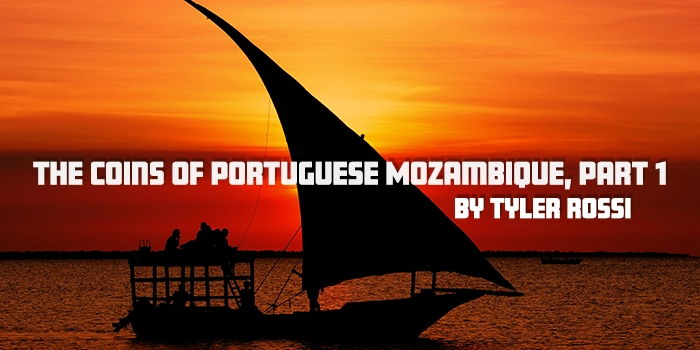
By Tyler Rossi for CoinWeek …..
Part 1 | Part 2
* * *
Portugal’s first contact with East Africa was during the “Age of Exploration” in the late 1400s. What followed was 500 years of direct, highly exploitative rule, lasting until the 1970s. Portugal’s East African holdings, originally a disjointed grouping of territories traditionally called África Oriental Portuguesa, eventually coalesced into Portuguese Mozambique. Shortly thereafter, trading posts were set up in 1498 by Vasco da Gama in the Zambezi basin. While the territory was later expanded by Lourenço Marques in the 1540s, it wasn’t until the 1800s that European control over the interior truly solidified
This process is mirrored by the colonial coinage of Portuguese Mozambique, which can be broken down roughly into three periods: the Early Hammered Real (until 1755), the Standard Real (1755-1910), and finally the Escudo (1911-1974).
Through the mid-18th century, Portugal treated Mozambique primarily as an outpost on the way to India. In fact, the colony’s coinage was produced exclusively by the East Indian Goa mint until the mid-1700s. Goa, along with the nearby mint in Diu, were the sole sources of coinage to all of Portugal’s Asian and African colonies. This included gold and silver pieces, in addition to smaller base metal coinage.
It wasn’t until 1755 that coinage operations for Portugal’s African Colonies became centralized and were subsequently struck in Lisbon. The Real would continue to be used in the colony for hundreds of years, until the introduction of the Escudo in 1911. Around this time, the colony also relied heavily on a combination of privately issued company and plantation tokens.
Phase One: Early Hammered Real Coinage
The first coinage dedicated solely for Mozambique was struck under King João V, who ruled from 1706 to 1750. Prior to these coins, any circulating currency in the colony was struck either for use domestically in Portugal, other Portuguese colonies (usually India or Brazil), or in another country (i.e., British, Spanish, or Arabic coins). While they have no date, the first series was struck by the Goa mint in 1725 and consist of three copper denominations: the 10, 15, and 30 Reis. The 10 and 15 Reis coins, which were struck periodically until 1750, shared the same obverse of João’s crowned Coat of Arms flanked by an M and an E, meaning “M(oçambiqu)E”. While the 30 Reis denomination also employed the same design elements, they were more detailed – as can be seen in the example below.
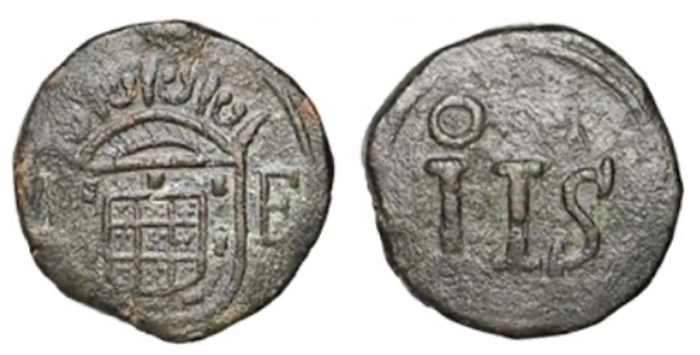

The three reverse designs also all follow the same design conventions, with the King’s initials IO (Ioanes/John/João) and then the denomination. The only differences are that on the 15 Reis, the number 15 is written as 1S, and the 30 Reis includes a V for João V.
Slightly later in 1735, a series of three silver denominations (200, 400, and 800 Reis) was introduced in Mozambique. All three coins were identical, save for the denomination on the bottom of the reverse design. The obverses all displayed a large image of João’s crowned Coat of Arms flanked this time by a G and an A – an early mintmark representing the Goa mint. The reverses all have a large equal-armed cross with the date interspersed between the arms all surrounded by the legend OAHN – ES V R P, separated by the denomination.

One notable feature of the early Mozambique coinage produced at Goa is that they were hand struck and as a result are rather crude.
Phase Two: Standard Real Coinage
Five years after King João V died in 1750, his son Joseph I authorized the striking of a new coinage for Mozambique. This one-year series consisted entirely of silver and gold coins. The silver series, all struck from .9166 silver, consisted of four denominations: 100, 200, 400, and 800 Reis. The largest, the 800 Reis, weighed 14.4 grams and was roughly equal to a Spanish 4 real coin.

All of the silver denominations share the same design of a crowned Coat of Arms on the obverse separating the date (1755) and denomination to the left. The reverse is dominated by the Portuguese armillary sphere superimposed on an equal-armed cross.
The three gold denominations are quite interesting. Worth a whopping 1,000, 2,000, and 4,000 Reis, the combined mintage of all three denominations equaled only 2,539 coins weighing 203 troy ounces or 6.314 kg. These pieces were all struck during the summer of 1755 and quickly delivered to the Casa da Índia’s headquarters located at Lisbon’s central harbor. This state-run corporation was in charge of regulating Portugal’s international and colonial trade. However, before the coins could be shipped to Mozambique, disaster struck. In the Great Earthquake of November 1, 1755, nearly all of Lisbon was destroyed, including the Casa da Índia’s headquarters. Afterward, only a portion of the coins was able to be recovered and shipped to Mozambique.

As with the silver denominations, the gold types are all the same. The obverse design of this special issue was quite similar to the silver denominations, save for the legend. Instead of IOSEPHUS.I.DG.PORT.REX.ET.D.AF.OR., they read IOSEPHUS.I.DG.PORTUG.REX. The reverse legend, ringing a quadrilobed cross, reads ET.DOMINUS.AF.OR.ANNO.1755 (tr. “Lord of East Africa – Year 1755”).
Joseph also was responsible for a series of countermarked coins. First authorized on the 20th of August 1760 under Governor Pedro de Saldanha de Albuquerque, Mozambique authorities began countermarking a number of coins with an M, standing for Mozambique. This designated the host coins as legal tender within Mozambique. Later in 1965, Governor Baltazar Manoel Pereira do Lago replaced the M with an MR that was used until 1767.
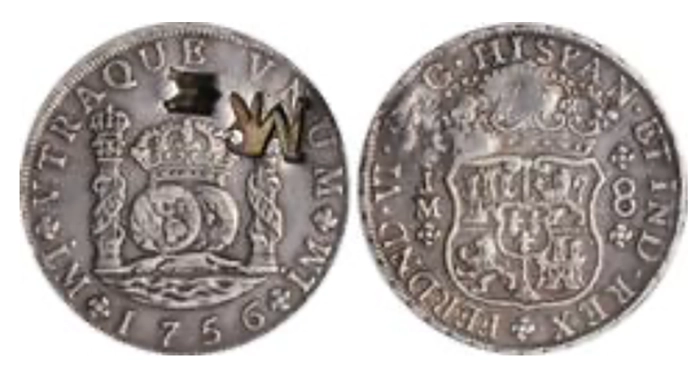
While these countermarks can be found most commonly on Spanish 8 real coins, they were also applied to many other coins. This host coin, for example, is a 600 Reis issued by João V in 1755 for his Brazilian colony.
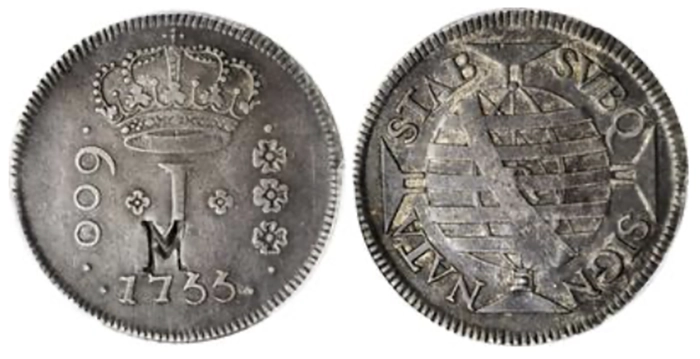
Perhaps even more interestingly, these countermarks were not just used for silver coins, but also on bronze and gold pieces.

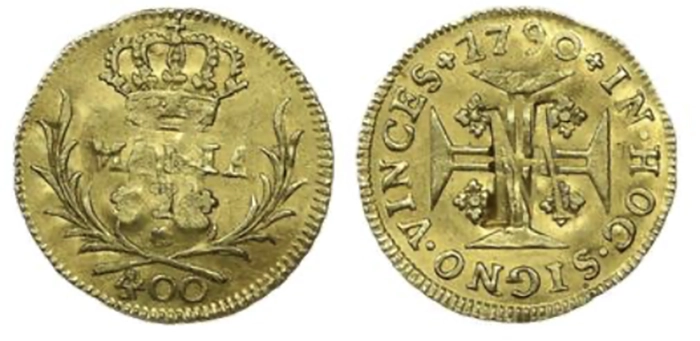
The next coinage issued in Mozambique was actually a mistake.
Struck in 1820 by the Rio De Janeiro mint during the reign of João VI, these coins were actually intended to be shipped to the colony of São Tomé & Principe. For some reason, they were sent to Mozambique and subsequently placed into circulation. This one-year issue consists of three bronze denominations worth 20, 40, and 80 Reis. All three denominations depicted the same design, with the Portuguese armillary sphere superimposed on an equal-armed cross on the obverse and a crown separating the legend JOANNES.VI.DG.PORT.BRAS.ET.ALG.REX, with denomination and date within.
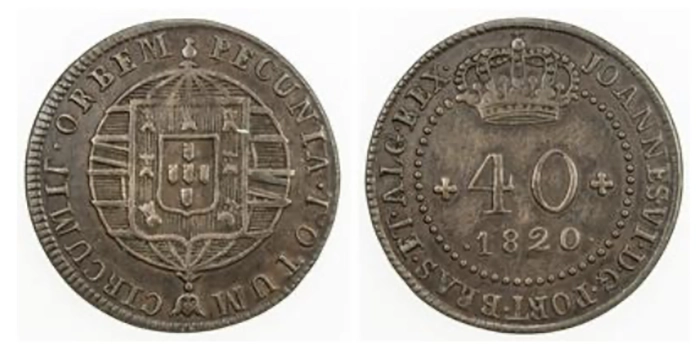
Maria II (r. 1834 to 1853) followed this issuance 20 years later by striking another one-year issuance of small-denomination bronze coins. While these new 20, 40, and 80 Reis coins are similar to the earlier Rio De Janeiro types, their obverse harkens back to the earlier designs and depicts the crowned Royal Coat of Arms. The shared reverse has the legend PECUNIA TOTUM CIRCUMIT ORBEM rapping around a wreath, with the date and denomination within. Later, in 1853, the Queen also struck two smaller denominations with similar designs, the 1 and 2 real coins.
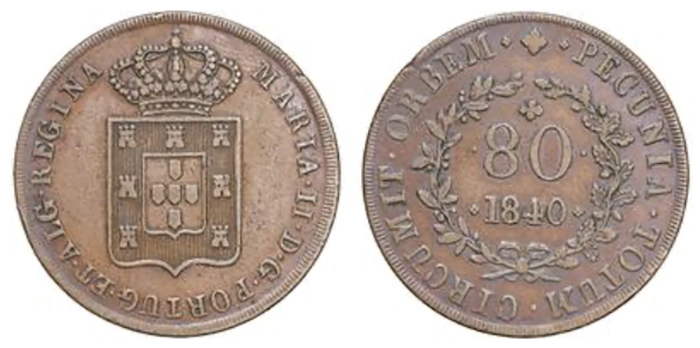

Maria II was also responsible for some of the most unique coins struck for Mozambique – a series of crude, rectangular bullion coins. The silver type that weighs 28.5g is denominated as an Onca, or 6 Cruzados, and was worth roughly 2,880 Reis.

The gold type comes in two denominations: the 1¼ and 2½ Meticais, both with the same design. On the obverse is a large M within a beaded circle and the denomination on the reverse.

Finally, the first two phases of Portuguese colonial currency ended with the reigns of Luiz (r. 1861 to 1889) and Carlos I (r. 1889 to 1908). Instead of striking their own coins for the colony, these Monarchs returned to the earlier practice of counter-stamping foreign coins. Issued in the last year of his reign on January 5, Luiz employed a crowned PM as his mintmark. On the other hand, Carlos I used a simple PM. This change happened because the old Crowned PM stamp of Luiz I broke, and the local authorities decided to just us a simple PM.

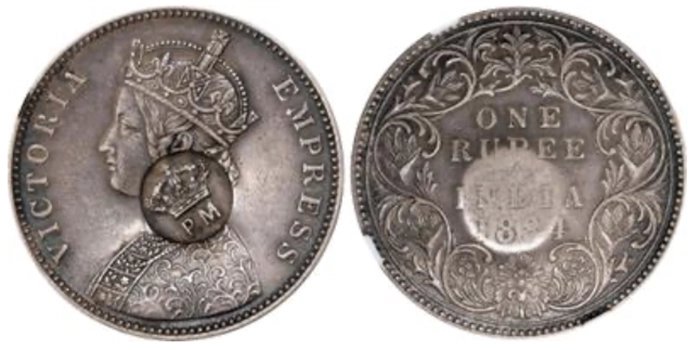
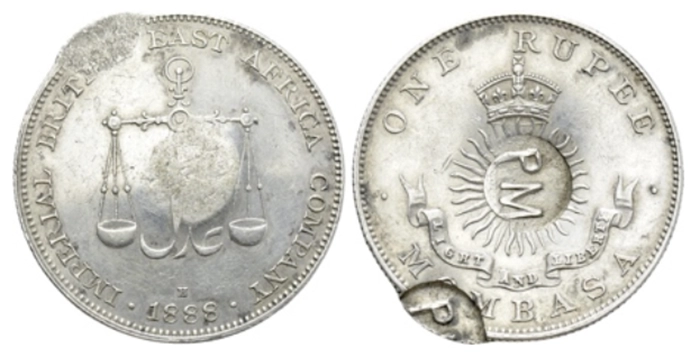
Auction 76, Lot 821 – 07.04.2019
After Carlos I passed away, Portugal experienced dramatic economic issues and was unable to issue any new coinage for their East African colony. At this time, the economy began relying on privately issued tokens. The Real was then replaced by the Escudo in 1911. However, it wouldn’t be until 1935 that Portugal actually began striking these new Mozambique Escudo coins.
* * *
Sources
Standard Catalog of World Coins – 1701–1800, 7th Edition. Krause Publications. (2016)
Standard Catalog of World Coins – 1801–1900, 9th Edition. Krause Publications. (2019)
https://www.mortonandeden.com/wp-content/uploads/2019/02/58.pdf
https://script.byu.edu/Pages/the-portuguese-documents-pages/portuguese-currency
https://projects.kora.matrix.msu.edu/files/210-849-30102/PWACOA12-68Portopt.pdf
* * *
About the Author
Tyler Rossi is currently a graduate student at Brandeis University’s Heller School of Social Policy and Management and studies Sustainable International Development and Conflict Resolution. Before graduating from American University in Washington D.C., he worked for Save the Children creating and running international development projects. Recently, Tyler returned to the US from living abroad in the Republic of North Macedonia, where he served as a Peace Corps volunteer for three years. Tyler is an avid numismatist and for over a decade has cultivated a deep interest in pre-modern and ancient coinage from around the world. He is a member of the American Numismatic Association (ANA).




